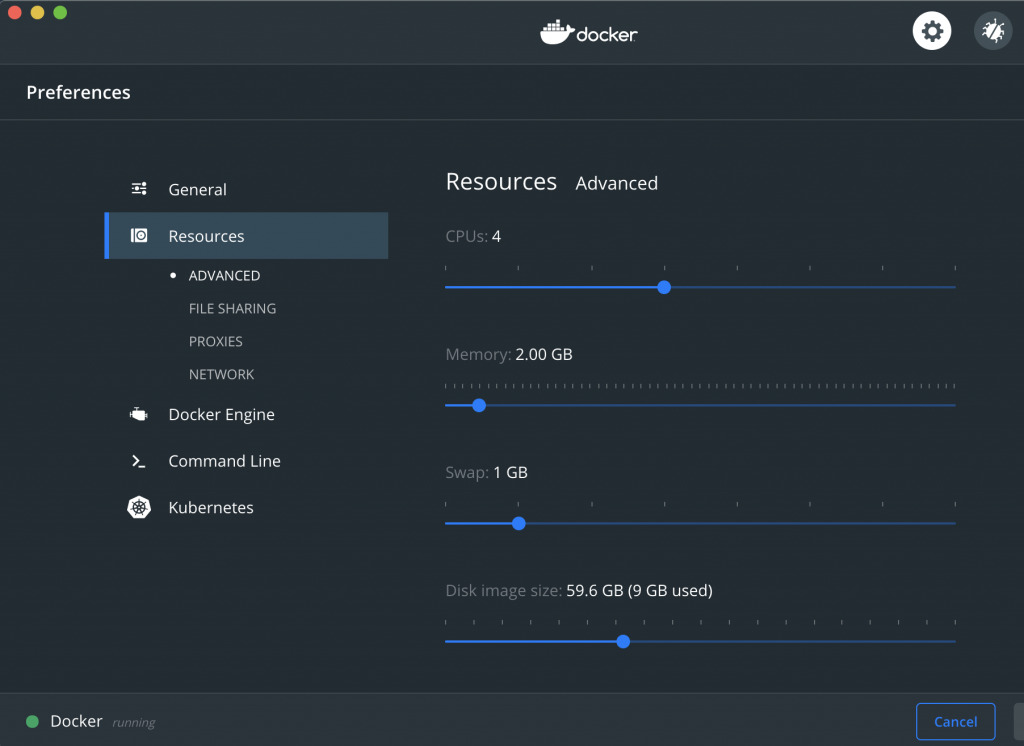

Docker Hyperkit Using 2Gb Of Memory Mac Is A
The text was updated successfully, but these errors were encountered: ijc added kind/enhancement version/1.12.0 area/hyperkit labels on Aug 9, 2016.Running Dockerized apps on the Mac. Configured MobyLinux VM with a fixed memory of 2GB.docker ps -> no containers running, but consuming a lot of memory com.docker.hyperkit (3,49 gb) Only restarting the docker engine VirtualMachine (using hyperkit) free the memory. Docker for Mac is a desktop app which allows building, testing andFix Docker For Windows unable to start in some cases : removed use of libgmp sometimes causing the.
Docker run -v orDocker run -mount) then the open/ read/ write/… calls are forwarded and the file is accessed If the path is on a volume mapped from the host or from a remote server (via e.g. If the path is on a tmpfs filesystem, the file is created in memory. what’s in the Docker.raw (or Docker.qcow2) What’s in the Docker.raw (or Docker.qcow)?If a container creates or writes to a file then the effect depends on the path, for example: The VM boots from anSingle writable disk image stored on the Mac’s filesystem in the~/Library/Containers/com.docker.docker/Data/com.docker.driver.amd64-linuxDocker.qcow2 or Docker.raw, depending on the format.Over time this file can grow and become large. The CPU usage was very low (0.3), memory usage 4.4Mb of 2Gb limit.Moby open-source project.

To modify a sector, the firmware will allocate a fresh block and, to avoid the device fillingUp with almost-empty blocks containing only one sector, will consider moving some existing data into it.If the filesystem writing to the SSD tends to favour writing to unused blocks, then creating and removingFiles will cause the SSD to fill up (from the point of view of the firmware) with stale data (from the pointOf view of the filesystem). TheDrive firmware runs a garbage collector, keeping track of which blocks are free and where user dataIs stored. SSDs are only able to erase data in large blocks (where the“erase block” size is different from the exposed sector size) and the erase operation is quite slow. Aside: SSD drives have a similar problemSSD drives suffer from the same phenomenon.
This is because APFS supportsAn API for deallocating blocks from inside a file, while HFS+ does not. It can be seen via theCtr command: $ docker run -rm -it -privileged -pid=host walkerlee/nsenter -t 1 -m -u -i -n ctr t lsWhen an image deletion event is received, the process waits for a few seconds (in case other images are being) and then runs fstrim on the filesystem.Returning to the example in the previous section, if you delete the 1 GiB file inside the alpine container / # rm -f 1GiBThen run fstrim manually from a terminal in the host: $ docker run -rm -it -privileged -pid=host walkerlee/nsenter -t 1 -m -u -i -n fstrim /var/lib/dockerThen check the file size: $ ls -s Docker.rawThe file is back to (approximately) it’s original size – the space has finally been freed! The codeThere are two separate implementations of TRIM in Docker for Mac: one for Docker.qcow2 and one for Docker.raw.On High Sierra running on an SSD, the default filesystem isAnd we use Docker.raw by default. Docker for Mac to deallocate the blocks in the host filesystem, shrinking the file.So how do we make this work? Automatic TRIM in Docker for MacIn Docker for Mac 17.11 there is a containerd “task”Called trim-after-delete listening for Docker image deletion events. an SSD drive to erase and reuse the space, rather than spend time shuffling it around and TRIMA TRIM command (or a DISCARD or UNMAP) allows aFilesystem to signal to a disk that a range of sectors contain stale data and they can be forgotten.
ATA_SUPPORT_DSM_TRIM: we support the TRIM commandOnce enabled the Linux kernel will send us TRIM commands which we implement withWith the caveat that the sector size in the VM is currently 512, while the sector size on the host canBe different (it’s probably 4096) which means we have to be careful with alignment.The support for TRIM in Docker.qcow2 is via theWhich manages a free list of TRIM’ed blocks within theFile and then performs background compaction and erasure (similar to the firmware on an SSD).The GC must run concurrently and with lower priority than reads and writes from the VM, otherwiseLinux will timeout and attempt to reset the AHCI controller (which unfortunately isn’t implemented fully).Includes both data blocks and metadata blocks, where the metadata blocks contain references to other blocks.When performing a compaction of the file, care must be taken to flush copies of blocks to stable storageBefore updating references to them, otherwise the writes could be permuted leading to the reference updateBeing persisted but not the data copy – corrupting the file.Flushes are very slow (taking maybe 10ms), block copies are done in large batches to spread the cost.If the VM writes to one of the blocks being copied, then that block copy must be cancelled and retried later.All of this means that the code is much more complicated and much slower than the Docker. The result of reading after TRIM won’t change) ATA_SUPPORT_DRAT: we guarantee Deterministic-Read-After-TRIM (DRAT) (i.e. ATA_SUPPORT_RZAT: we guarantee to Read-Zero-After-TRIM (RZAT)


 0 kommentar(er)
0 kommentar(er)
